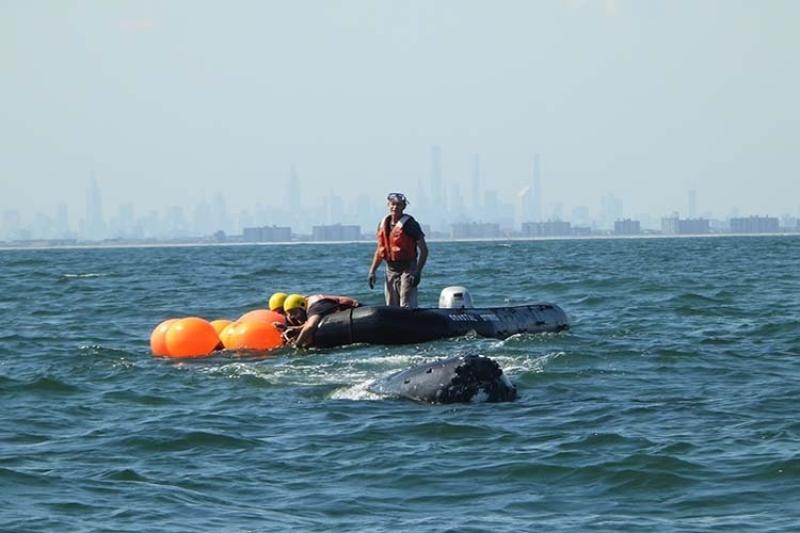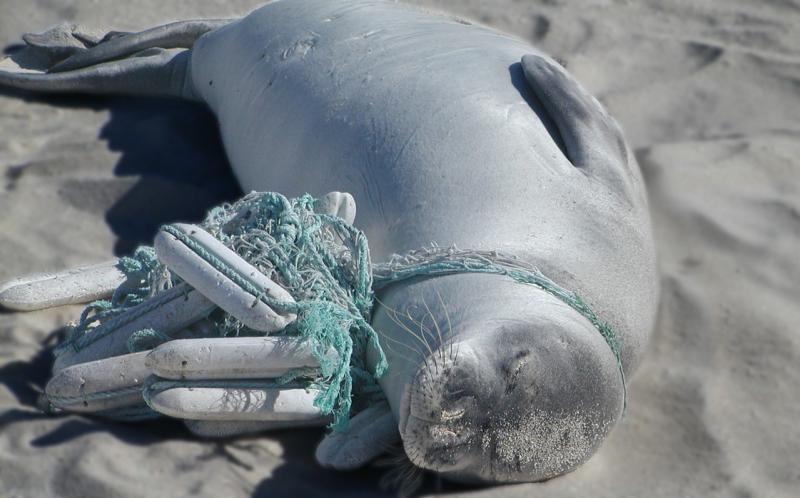NOAA Fisheries was notified by the U.S. Coast Guard of a distressed humpback whale in the Ambrose Channel of New York on Monday, July 27. One of our New York stranding network partners, the Atlantic Marine Conservation Society (AMSEAS), immediately began working with the New York State Department of Environmental Conservation (NYSDEC) on plans to get a good look at the animal and confirm its location. AMSEAS discussed the situation with the Center for Coastal Studies (CCS) in Provincetown, Massachusetts, our lead authorized disentanglement partner for the area.
Monday
On Monday evening, AMSEAS went out with NYSDEC staff on one of their vessels to the location provided by the U.S. Coast Guard. They determined the whale was still alive and able to breathe. It appeared to be anchored in place but staff could not see any entangling material.
In this case, there were multiple threats to the whale. It could not perform normal behaviors, such as feeding, and was at severe risk of being struck by ships or attacked by predators. It was anchored to the sea floor and could barely make it to the surface to breathe.
Tuesday
After reviewing the initial photos from Monday, AMSEAS and NYSDEC returned to the whale on Tuesday. They were were able to secure better images confirming the entanglement and its configuration, which were holding the whale’s tail down. They relayed this information back to CCS and NOAA and further assessing the urgent situation. Then we worked together to plan for a disentanglement attempt.
Wednesday
On Wednesday morning, USCG verified that the whale was still anchored in the same position. CCS disentanglement staff were flown from Massachusetts to New York on a flight donated by our partners at Turtles Fly Too.
“We’re proud to be a part of these emergency missions providing aviation transport for the animals themselves, and in this case, getting rescue team members on-scene quickly. Transportation by air results in faster response times, reduced stress for the injured animals, and gives the rescue teams the ability to save more animals,” said Leslie Weinstein, president of Turtles Fly Too.
Staff from AMSEAS met the CCS team at the airport, where they proceeded to the boat launch at the Jones Beach State Park. The CCS and AMSEAS teams were transported to the scene in vessels provided by NYSDEC. CCS staff used their inflatable vessel to attempt to disentangle the whale.
By Wednesday afternoon, the disentanglement team was able to remove multiple buoys and make cuts through pieces of entangling gear around the whale’s flukes. Despite their best efforts, the whale was still anchored in place. The team had to leave the whale when it got too dark to continue safely.
Thursday
Early Thursday morning, the NYSDEC vessels with the AMSEAS and CCS teams were back on the water. The research vessel Heidi Lynn Sculthorpe, from Monmouth University’s Urban Coast Institute, transported a team member from NOAA Northeast Fisheries Science Center’s Sandy Hook lab to the whale. Crews worked with the R/V Heidi Lynn Sculthorpe and the U.S. Army Corps of Engineers Drift Collection Vessel HAYWARD. They used heavy equipment to secure and haul some of the heavy gear, which allowed the CCS team to make cuts that relieved pressure on the whale’s body. Around 4 p.m., final cuts were made releasing the whale from a very large and complicated entanglement.
The teams stayed on scene to assess the health of the whale as it swam free. The visible injuries to the whale did not appear to be severe. They did include multiple lacerations to all body areas and some deep lacerations at its tail.
This event demonstrated the need for a deliberate approach with patience and endurance, and the collaboration of local resources and expertise to support a skilled and experienced disentanglement team.
“That was among the more challenging whale disentanglement cases we have dealt with. That whale was fighting to live. All the folks we were working with on the water the last two days were fighting to help it”, said Scott Landry, CCS Director of Marine Animal Entanglement Response. “Without intervention that whale would not have survived. While it’s not entirely out of the woods yet, it’s prospects are now 100 percent better than what they were. We are optimistic we will see the whale again and like the majority of humpback whales off our coast it will bear the scars of entanglement.”
“Whale response in New York has been increasingly complex over the years, and this event was an especially challenging one,” said Rob DiGiovanni, Executive Director and Chief Scientist of AMSEAS. “In these difficult times, with these difficult conditions, AMSEAS is honored to be working with our partners on the water—NYSDEC, Center for Coastal Studies, Army Corps of Engineers, the U.S. Coast Guard and Monmouth University—as well as NOAA Fisheries and Turtles Fly Too. The observational information gathered from photos and other documentation during the first two days provided valuable information that helped lead to the development of a successful plan. These data enabled the team to stage the appropriate resources to address the changing conditions. It is reassuring to know that we have partners to call on to get this important job done.”
“[NYS]DEC was proud to help initiate, coordinate, and co-lead the rescue of one of nature’s most impressive animals so that it can once again enjoy its home in our abundant coastal waters,” said NYSDEC Commissioner Basil Seggos. “This collaboration of state, federal, academic, and not-for-profit partners is a remarkable example of what happens when we work together to protect our environment and the creatures that depend on it.”
We are thankful to the recreational boaters who initially called this report into USCG. Mariners are encouraged to immediately report sightings of injured or entangled whales. In New York, please call the New York State Stranding hotline at (631) 369-9829; from Maine through Virginia, call (866) 755-6622 (NOAA).
This work was conducted under Permit 18786-04, issued to the NOAA Fisheries Marine Mammal Health and Stranding Response Program.
Thank You, Partners!
We are extremely grateful to all of our partners who were involved in what turned out to be one of the most complex whale entanglements we have encountered. Because of them, this whale was given a second chance at life.
- U.S.Coast Guard Sector New York—For notifying us of the whale, providing its location, and providing updates, assessing the whale on July 29 so operations could continue.
- NYDEC—For providing logistics and coordination, including vessels and transport for AMSEAS and CCS teams out to the whale each day since it was first reported by the USCG on Monday. Additionally for staff, equipment, and on-water security support during on-water activities (particularly important from a human-safety perspective).
- AMSEAS—For working with NYSDEC to locate and assess the whale. And for taking the lead on coordinating the disengagement effort with CCS and NOAA, including managing all on-the-ground logistics.
- CCS—For quickly mobilizing to make the disentanglement attempt possible, including reaching out to our partners at Turtles Fly Too for air transport to New York. Most importantly, for providing their disentanglement expertise throughout the event and leading the actual disentanglement effort.
- Turtles Fly Too—For working with their Turtle Flyer pilots to secure air transport for the CCS team from Massachusetts to New York and for being incredibly flexible with pilots standing by for the return flight as the operation endured.
- Monmouth University Urban Coast Institute—For support vessel for July 30 operation to secure gear, including carrying NEFSC staff to location.
- NEFSC Sandy Hook Lab—For staff support for July 30 operation to secure gear.
- Army Corps of Engineers—For vessel support for July 30 operation to secure gear.






